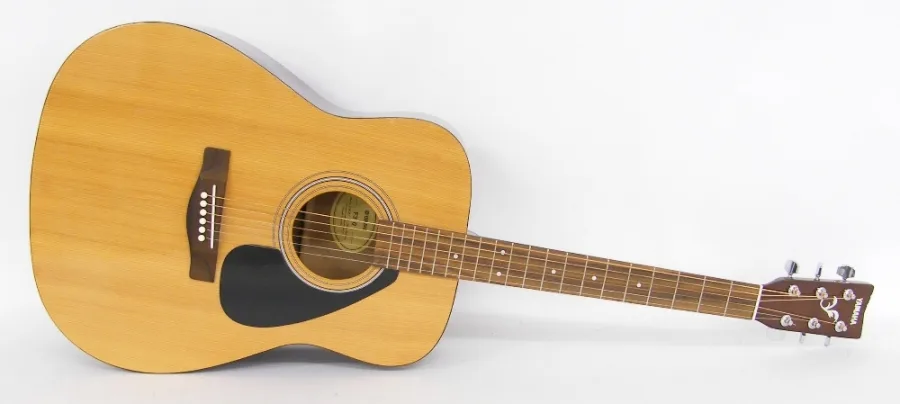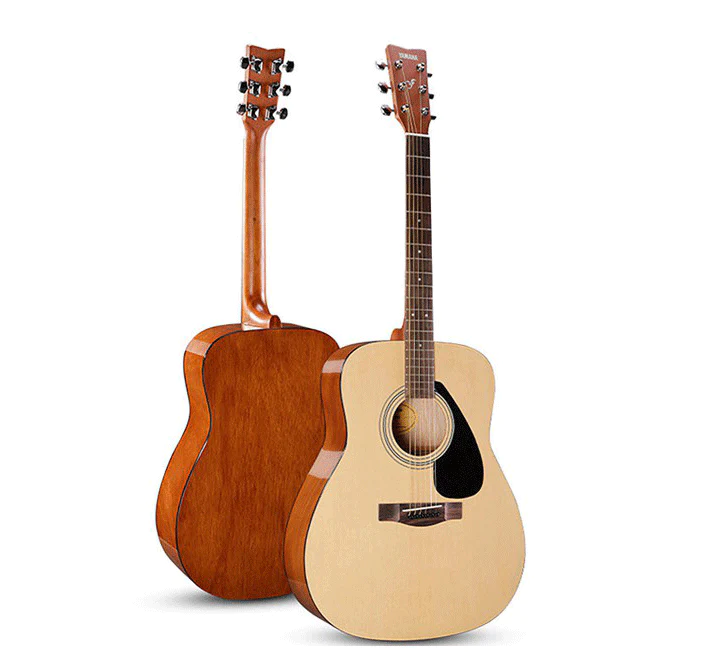Have you been searching for the perfect guitar but wondering where it’s made? Look no further! In this article, I’ll uncover the truth about the Yamaha F310 – one of the most popular acoustic guitars on the market. As a musician myself, I understand how important it is to know where your instrument comes from and what goes into its making. So let’s delve into the origins of this beloved guitar and discover why its origin plays a significant role in its quality. Keep reading to find out all about where Yamaha F310 is made!
So, Where is Yamaha F310 made??
The Yamaha F310 is a popular acoustic guitar known for its quality sound and affordable price. Many people wonder where this instrument is made, as the origin of a product can often reveal important information about its quality.
The answer to this question is that the Yamaha F310 is made in Indonesia. This may come as a surprise to some, as many assume that high-quality musical instruments are only produced in countries like Japan or the United States. However, over the years, Indonesia has become a major player in the music industry and has gained recognition for producing top-notch instruments.
But why choose Indonesia? The country’s rich culture and history have long been intertwined with music, making it an ideal place for crafting musical instruments. Additionally, labor costs are lower in Indonesia compared to other countries such as Japan or the US, allowing companies like Yamaha to produce high-quality products at more affordable prices.
Despite being manufactured in Indonesia, the Yamaha F310 still goes through rigorous quality control processes to ensure that it meets Yamaha’s standards of excellence. Each guitar undergoes thorough testing before leaving the factory to ensure that it produces clear tones and has durable construction.
Furthermore, by manufacturing their guitars in Indonesia instead of outsourcing production elsewhere, Yamaha also supports local economies and provides job opportunities for skilled craftsmen.
In conclusion, while some may have reservations about products made outside of well-known manufacturing hubs like Japan or USA, rest assured that the Yamaha F310 maintains its reputation for excellent sound and quality despite being made in Indonesia. Its origin adds depth to its story and highlights how global collaboration can result in exceptional products loved by musicians all around the world.
Understanding the History of Yamaha Corporation
Yamaha Corporation has a fascinating history that weaves together music, innovation, and craftsmanship. Founded in 1887 by Torakusu Yamaha, the company originally focused on producing reed organs. The founder’s first organ was so well-made that it set the tone for the company’s future. This humble beginning marked Yamaha’s dedication to quality and precision. Over time, their product line expanded significantly to include pianos, motorcycles, and electronic goods.
As years passed, Yamaha diversified its offerings while maintaining a high standard of excellence. By introducing state-of-the-art technologies into musical instruments like synthesizers and digital keyboards in the latter half of the 20th century, they stayed at the forefront of innovation. They also entered new markets through strategic acquisitions such as Steinberg Media Technologies in 2004.
– Musical Instruments
– Pianos
– Guitars
– Synthesizers
– Motorcycles
Their commitment to creativity didn’t stop with music; Yamaha Motor Co., Ltd was established separately but shared similar values of ingenuity and design prowess as its parent company.
Additionally, they ventured into audio equipment with impressive results—considering how their AV receivers are renowned today for top-notch sound quality. From reed organs to cutting-edge technology products across various industries—Yamaha‘s journey is nothing short of inspiring.
The Manufacturing Process of Yamaha F310 Guitar
When it comes to crafting the Yamaha F310 guitar, the journey begins with selecting high-quality toonwoods. This instrument is renowned for its rich sound and durability, thanks in large part to materials like spruce for the top and mahogany or meranti for the back and sides. These woods are carefully chosen not just for their aesthetic appeal but also for their acoustic properties. Once selected, they undergo a thorough drying process to ensure stability and longevity. The wood is cut into precise shapes that will form various parts of the guitar.
The assembly phase is where art meets science. Skilled artisans meticulously glue these wooden pieces together to form the body of the guitar, paying close attention to alignment and symmetry. A special type of adhesive ensures a strong bond without compromising on sound quality. After this step, craftsmen attach braces inside the body which play a crucial role in enhancing resonance while maintaining structural integrity.
Next comes attaching other essential components such as:
- The fretboard
- The bridge
- Machine heads
These elements are added with precision tools, ensuring each piece aligns perfectly.
Finally, multiple layers of lacquer are applied by hand; this provides protection while allowing natural vibrations from playing you can feel reverberate through your bones.
Read also: Which guitar is best for 12 year old?
Why The Origin Of Your Guitar Matters?
Knowing where your guitar comes from is more than a trivial fact. It’s like understanding the roots of a cherished family heirloom. When you know your guitar’s origin, it brings an extra layer of meaning to every chord you strum and every note that resonates through its strings. Imagine holding a piece crafted by artisans in Spain or luthiers in America; each carries a rich history and unique craftsmanship. The wood they select, the techniques they employ, and even the climate can influence how your instrument sounds and feels.
Additionally, discovering your guitar’s origins can reveal ethical dimensions worth considering. Some guitars are made using sustainable woods while others might contribute to deforestation or unfair labor practices. By choosing instruments with transparent backgrounds about their sources, you’re supporting responsible production methods. This awareness not only enhances your musical journey but also connects you to something larger—be it environmental stewardship or cultural heritage—allowing each melody played to carry deeper significance.
– Enhances personal connection
– Reveals craftsmanship details
– Unveils ethical considerations
So next time you pick up that beautiful six-string wonder, take a moment to ponder where it’s been before arriving in your hands—it just might transform the way you play forever.

Yamaha F310 Guitar: Quality and Craftsmanship from Japan
I’ve played many guitars over the years, but there’s something truly magical about the Yamaha F310. It’s like this instrument has a soul of its own. Crafted with such precision and care in Japan, it showcases what real craftsmanship is all about. The moment you strum your first chord, you can feel the love that went into making it.
The wood used is top-notch; spruce on the top and meranti on the back and sides give it a rich, warm sound that resonates beautifully. It’s not just easy on the ears either—it looks stunning with its natural finish highlighting every grain of wood. Whether you’re practicing at home or performing for friends, it’s reliable as well as visually appealing.
– Top: Spruce
– Back & Sides: Meranti
– Neck: Nato
And let’s talk about playability for a second—it’s fantastic! The neck is smooth and comfortable to hold, making those long practice sessions much more enjoyable. Plus, it’s incredibly durable; I’ve traveled quite a bit with mine and it’s held up like a champ.
So if you’re looking for an acoustic guitar that’s affordable yet doesn’t skimp on quality or craftsmanship, you really can’t go wrong with this one from Yamaha.
It’s perfect whether you’re just starting out or have been playing for years!
You may also like: was liberace a good piano player
Unveiling the Truth About Where Yamaha F310 Guitar is Made
The Yamaha F310 is a favorite among budding guitarists, and it’s easy to see why. But have you ever wondered where this beloved instrument comes from? The story begins in the factories of Indonesia. It’s here that skilled artisans take raw materials and transform them into beautiful guitars ready to create music all around the world. This specific choice of location isn’t random; Indonesia boasts a rich history of craftsmanship and an abundance of quality woods like spruce and mahogany, perfect for making durable instruments with excellent sound.
The creation process combines traditional handcrafting methods with modern technology. Workers carefully cut, sand, and assemble each piece with precision. Imagine rows upon rows of wooden frames slowly taking shape until they resemble the iconic silhouette we recognize as a guitar. After assembly, each instrument goes through rigorous testing processes to ensure its tonal quality matches Yamaha’s high standards before it’s deemed ready for distribution.
– High-quality Indonesian wood
– Skilled artisans
– Blend of tradition & technology
When your fingers glide over the strings and you hear that first melodious note resonate from your Yamaha F310, you’re experiencing what can only be described as a labor of love from halfway across the globe. Behind every strum lies hours of meticulous crafting by hands that have honed their skills over generations—each guitar tells its own unique story long before it reaches yours.
Conclusion: Why the Origins Matter in Choosing Your Guitar
There’s something magical about a guitar with a story. Think of guitars made in the heart of Spain or Italy; these places are steeped in history and tradition. The woodwork, the craftsmanship, it’s all part of what makes each instrument unique. When you hold one of these guitars, you’re not just holding an object—you’re cradling years, sometimes centuries, of expertise passed down through generations. Every strum feels like you’re tapping into that rich lineage.
On the flip side, you might find yourself drawn to modern factories where innovation is at its peak. These places blend cutting-edge technology with skilled artisanship to create instruments that sound phenomenal and stand up to rigorous playing conditions.
- Traditional Craftsmanship: Offers a historical connection and timeless quality.
- Modern Innovation: Provides durability and advanced sound techniques.
Understanding where your guitar comes from can make all the difference in your playing experience.
In choosing a guitar, appreciating its origins helps you connect on another level entirely. It’s more than just aesthetic value or how it sounds—it’s about feeling tied to something bigger than yourself. Whether it’s handcrafted by master luthiers in Europe or produced using state-of-the-art methods elsewhere, knowing its roots gives depth to your musical journey.
The love poured into creating that instrument echoes through every note you play.

